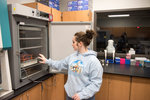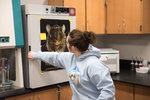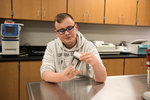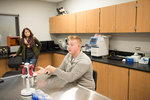



While most of us spent our high school biology classes squinting through dusty old microscopes and dissecting frogs, W.F. West students have already left such rudimentary learning in their past.
One student is studying how the light from cellphones affects mood using zebrafish. Another is testing the effectiveness of current flu vaccines and treatments. Another is designing a bioprinter that can print skin onto burn victims — last year he studied the rate at which cancer grows.
These teenagers’ science projects are already on par with graduate research, but advanced molecular genetics students at W.F. West High School will soon have access to something even more advanced.
This fall, science teacher Wendy Neal plans to implement a tool called “CRISPR.”
Put simply, CRISPR is a tool that can edit the base of a gene. Theoretically, the tool could be used to “fix” a strand of DNA by editing out something such as a hereditary disease in humans. Neal plans to begin using the tool on something simple to start with, such as yeast. She has only come across one other high school in the U.S. that is currently using CRISPR.
This year, Neal has three students in her advanced class, where they select an individual, yearlong project. Neal speaks casually about equipment in the high school’s lab, but the molecular genetics program is cutting edge.
The Chehalis Foundation and donors fund the equipment Neal purchases, and board members have encouraged her to push the envelope.
“They are very supportive and like ‘whatever you want to do, go for it,’” Neal said.
The Chehalis School District opened its STEM Wing at W.F. West High School in January 2018, after it secured a $5.5 million grant from the state in 2016. Chehalis Foundation board member and Chehalis School District assistant superintendent Mary Lou Bissett said the push for a STEM Wing came after students in the district were working on incredible science projects, without proper facilities. W.F. West High School assistant principal Tommy Elder said Neal has the go-ahead to implement pretty much whatever she wants into the high school’s molecular genetics program.
“Whatever she wants to do, we’re going to do it,” Elder said. “... She is the most amazing educator that I have had a chance to work with. She is committed to her kids and really pushing what we can do in a high school and the technology that kids have access to.”
First, though, Neal has to learn to use CRISPR, too. Previously, she has worked with the University of Washington to improve the high school’s molecular genetics program.
Recently, Neal and advanced molecular genetics students Dawson Brindle and Noah Layton visited the Aquatics Core at the University of Washington Institute for Stem Cell & Regenerative Medicine. The three learned more about how to start and maintain a colony of zebrafish as well as how to use a “microinjector,” which is essentially a microscopic needle that can inject a protein, virus or DNA into a zebrafish embryo.
As complex as humans are, we share 70 percent of our DNA with one tiny type of minnow — the zebrafish. It is a fish scientists use to study molecular genetics, and one that the high school students will soon have access to as well.
“They have a very quick turnaround,” Brindle said. “… It’s just an easy way to quickly see the effects of something in a very short time, but you can see a full spectrum of what it could cause — and they do share a lot of our same DNA.”
Brindle, 17, Layton, 17, and Rubilynn Saranchuk, 16, are all in Neal’s advanced molecular genetics class. Neal offers minimal direction, but suggests academic papers to read or helps a student narrow his or her focus.
None of the students live in the Chehalis School District. Each one commutes from a different town in Lewis County, specifically for W.F. West’s molecular genetics program.
Layton is currently studying the influenza virus and possible vaccines or medications for treatment. He is evaluating the effectiveness of current vaccines.
“There is a huge influenza pandemic predicted by the CDC (Centers for Disease Control) coming up,” Layton said. “So I thought it would be important to get a deeper look and see how our vaccines are working on our immune system, because zebrafishes’ immune systems, they’re very similar to humans’ and I’m able to see how they react to influenza virus and see how the vaccine combats it.”
Last year, Brindle used zebrafish to test a protein — called “growth factor beta 1” — that can be used in some cases of cancer to put a patient into 100 percent remission within the first term.
“If it’s after the first term, it can exponentially increase the rate at which cancer grows,” Brindle said. “So there is a very fine line between where it works and where it doesn’t. So I was kind of using zebrafish and treating them with that protein to see where that fine line was and why that line exists.”
This year, Brindle is working to design and build a bioprinter that can print skin onto burn victims, all the way around the victim’s arm.
These projects, Neal explained, are typically based on a personal interest.
“Either a grandparent has Parkinson’s or it’s something they are directly interested in,” Neal said. “Like, Rubilynn was interested in stress hormones. It’s like, do something you are interested in, or have a connection or a buy in with, and then you are more likely to carry it through — because it’s a lot of work.”
Rubilynn Saranchuk will also work with zebrafish this year. Saranchuk is studying the correlation between blue lights (i.e. the light emitted from cellphones) and cortisol levels (the hormone that controls mood and increases under stress).
“Blue light is emitted from phones and phones are a 21st century tool that everyone has,” Saranchuk said. “So I figured if we can find a direct correlation, we might be able to find a way to have a safer, less cortisol-inducing phone that might benefit everyone.”
Neal noted that while not all of her science students will go on to study molecular genetics, they will become voters. In all of her molecular genetics classes, she discusses the ethics behind genetic research.
“Part of it, too, is we are going to, as voting citizens, have to make decisions about what molecular geneticists can do,” Neal said. “... If they understand the procedures, they can make an informed decision about (what) is okay or not okay.”